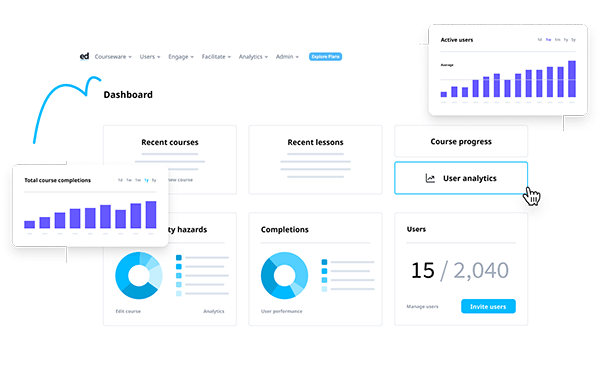How development and training can increase employee retention

The great car inventor Henry Ford is quoted as having said: “The only thing worse than training your employees and having them leave is not training them and having them stay.” As a manager, it’s important to ask yourself how you can have the best of both worlds. In this article, we’ll dive into how development and training can increase employee retention.
Thing is, most companies understand that new employees need support. However, the group that often gets overlooked is the workers you already have. Unless there is a specific need, such as updated machinery, procedures, or national guidelines, management thinks: “These people know their jobs, so they do not need any more nurture.” This could not be further from the truth.
Over 15 years of proof
More than one and a half decades of research continue to show how development and training can increase employee retention. Let’s look at three examples.
The Importance of Developing Strategies for Employee Retention
Omer Cloutier et. al.
This item is basically a review of research. It was published in 2015 and cites evidence before that time–essentially extending the proof to over 20 years.
The authors state that development and employee retention training have many positive effects on employees. For one, employees feel more of an important part of the organization. For another, they see themselves as part of a cohesive workforce.

The fact that their workplace has invested in them via development and training (proof that it recognizes their efforts and values) communicates to workers that they are a valued part of their workplace. All this increases their company loyalty and reduces their motivation to leave their jobs. Thus, creating instructional strategies for development and training is “critical for an organization’s employee retention strategy”.
International Conference on Business and Technology: Sustainable Finance, Digitalization and the Role of Technology: Impact of Employee’s Engagement and Task Identity on Employee’s Retention Strategy Mediated by Job Satisfaction
Ishaq Ibrahim et. al.
Jumping forward to 2022, we find a study on employee retention in Malaysian industries. The authors examined the direct impact of “employee engagement and task identity…on employee retention”, using job satisfaction as the mediating variable. Results indicated that these three variables had “a direct significant impact on employee retention”.

Combining what we learned from our previous example, we can reasonably say that development and training help to increase employee engagement, task identity, and job satisfaction. Thus, keeping them at the same job for longer.
International Journal of Hospitality Management, Volume 109: Reducing hotel employee turnover intention by promoting pride in job and meaning of work: A cross-cultural perspective
Linh H. Le et.al.
Our last example is from an ‘in progress’ journal volume. In other words, the journal volume is scheduled for publication in February 2023. So, it’s a good representation of the latest data on this topic.
Online surveys of American and Vietnamese hotel employees showed that “work centrality, obligation norms, and work values positively affected job pride which subsequently reduced turnover intention”. What does that mean in day-to-day language? Good question! Here are some definitions
Work centrality: How important work is for a person compared to other things in their life. In other words, how high it ranks in comparison to family, friends, free time, etc.
Obligation norms: Behaviors and rules that a person feels society says they have a duty to uphold.
Work values: The principles and standards that a person holds themself to on the job as a result of their own ideas. For example: be responsible; have self-motivation; be adaptable/flexible; have a positive attitude; etc.
This survey is a great summation of the two research items before, explaining how development and training can increase employee retention.
The results of the third research item clearly show that people’s attitudes toward work are very subjective. That is, each person has their own ideas and feelings about the importance of their work and how they should perform in their jobs.
Sure–employers can have a set of rules, procedures, and obligations. Yet, how well their employees will stick to that set is a very individual and personal matter.
How can organizations influence their workers’ attitudes toward work?
A big part of how people feel about work is influenced by how their work feels about them. It’s not just salaries and benefits (although they go a long way for sure). Yet, employees often turn down better-paid jobs to stay with employers who value their growth and who they feel a strong connection with.
Organizations that devote resources to developing and training all their employees shout out their appreciation. These companies are telling each worker: “You are valuable. It is worthwhile investing in you.”

In the past, companies needed classrooms, teachers, and materials. Each organization basically had to ‘invent the wheel’ for themselves. There was little or no way to collaborate. Large organizations were better off than small ones. More employees using the material per currency unit spent meant that their ROI on development and training was greater.
Today, however, the situation is completely different. Cloud-based, elearning development software takes development and training out of the classroom and onto people’s phones. The shared library can give you over 1000 courses that are ready to use ‘out of the box’ or editable as needed.

A template-based, creator tool means you can craft your own training in minutes, not hours. Accurate accountability features are included, such as checking if training outcomes have been met. All you need is a top-level LMS such as EdApp. Then, your organization is well on its way to increasing employee retention.
Outside sources
http://www.m.www.na-businesspress.com/JLAE/Pemberton-JonesEJ_Web12_2_.pdf
https://link.springer.com/chapter/10.1007/978-3-031-08084-5_40
https://www.sciencedirect.com/science/article/abs/pii/S0278431922002754
Author
